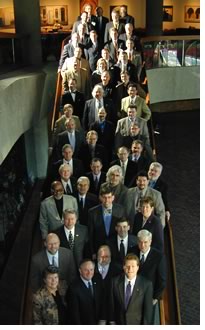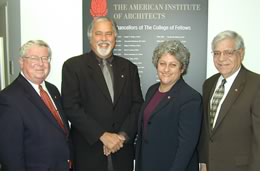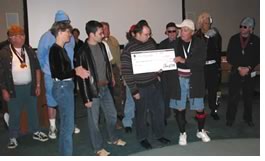
Previews research effort on design’s effect on human behavior
by Tricia Chamberlain
Director, Media Relations
Thompson E. Penney, FAIA, president and CEO of the Charleston, S.C.-based firm LS3P Associates Ltd., became the 79th president of the AIA December 6 during ceremonies held at Union Station in Washington, D.C. Penney succeeds Gordon H. Chong, FAIA.
 A
shift toward empathy
A
shift toward empathy
In his inaugural speech, Penney spoke of a changing social and cultural
environment, one in which people reevaluate what is truly important in
their lives. This shift in perception means that people are beginning
to expect more from their built environments. “We have an opportunity—unique
in our professional lives—to reach out, to make the connection in
the public’s mind between their growing hunger for value and what
we architects do,” Penney said.
He called on the audience to think about architecture as based on empathy and caring, with the power to provide design solutions that do, in fact, have greater value and deeper purpose. “We have an opportunity, not only to celebrate the poetry of our work, but to elevate the human spirit,” Penney said. “We also have an opportunity, and I would say the responsibility, to offer proof about how design enriches life.”
A major research agenda
Penney said that proof will come from scientific research illustrating
how design and architecture measurably affect human behavior. “Winston
Churchill is often cited for his observation that ‘we shape our buildings
... thereafter they shape us,’” Penney said. “But how,
and in what ways?” He announced that the AIA would support a major
research agenda to explore these questions, with a goal of quantification
of the value of design in verifiable ways our clients and the public understand
and trust.”
Penney discussed creating a body of scientific knowledge, based in neuroscience, that proves how the brain interacts with designed environments. Such research is beginning to occur at places of learning such as the Salk Institute, where scientists have launched the first efforts to measure the impact of the physical environment on the brain. “This research holds out the promise of a day when architectural design may be scientifically informed, and the impact could be as great if not greater than the impact that the understanding of physics had on structural and acoustical design in the 20th century,” he said.
 The
new president believes that design is one of the most visible signs of
our core values as individuals and as a society, and that providing scientific
proof about the real-life effects of a building on its inhabitants would
create a new perception of architecture and design. “We could design
education into our schools, curing into our hospitals, and dignity into
low-income housing,” declared Penney. “We all know this in our
hearts, but we are less sure when we try to make this case empirically
to our clients and the public.”
The
new president believes that design is one of the most visible signs of
our core values as individuals and as a society, and that providing scientific
proof about the real-life effects of a building on its inhabitants would
create a new perception of architecture and design. “We could design
education into our schools, curing into our hospitals, and dignity into
low-income housing,” declared Penney. “We all know this in our
hearts, but we are less sure when we try to make this case empirically
to our clients and the public.”
Longstanding leader
Penney has been active in the AIA since his student days. He earned a
bachelor of arts in 1972 and masters of architecture in 1974 from Clemson
University. In 1990, he was elevated to the College of Fellows and over
the years has received numerous state, regional, and national awards for
design excellence. Under Penney’s leadership, the 150-person LS3P
has grown to become a well-known regional firm with offices in Charleston,
S.C., and Charlotte. Engineering News-Record
recognized LS3P as one of the fastest rising in the top 500 design firms
in the U.S.
Throughout his career, Penney has served in various leadership positions within the Institute, including: president, AIA Charleston (1981); president, AIA South Carolina (1994); and South Atlantic Region director (1998–2001). He served two terms as the president of the Clemson Advancement Foundation for Design + Building and, in 1999, received the university’s Distinguished Service Award, Clemson’s highest alumni honor.
Investing in the future
Joining Penney at the AIA helm is the “Class of 2005,” 15 new
directors on the AIA Board. They bring with them a long-range strategic
plan for the Institute for 2003–2005 and a supporting
operating plan of programs and projects for 2003–2004. The plans
are heavily based on member input from diverse populations of the AIA.
 Also
joining the leadership of the AIA is the new executive committee of the
College of Fellows: Chancellor Sylvester Damianos, FAIA; Vice Chancellor
Betsey O. Dougherty, FAIA; Secretary Lawrence J. Leis, FAIA; and Bursar
Ted P. Pappas, FAIA.
Also
joining the leadership of the AIA is the new executive committee of the
College of Fellows: Chancellor Sylvester Damianos, FAIA; Vice Chancellor
Betsey O. Dougherty, FAIA; Secretary Lawrence J. Leis, FAIA; and Bursar
Ted P. Pappas, FAIA.
Finally, the Board’s outgoing Class of 2002 retired in style, performing a “rap” of farewell for 2002 President Gordon H. Chong, FAIA, at the AIA’s annual Fun Night festivities, and then presented a $12,000 check of personal funds to the American Institute of Architecture Students.
Copyright 2002 The American Institute of Architects. All rights reserved.
![]()